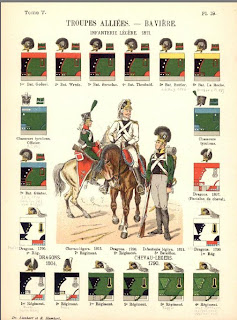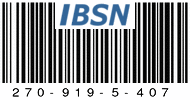Wurtembergs were present at Leipzig as well as in the battles of Gross-Beeren and Dennewitz forming part of the polyglot French IV Corps (Bertrand).
There are some inconsistences amongst the sources I have used for the strenght of the Wurtemberger infantry at Gross-Beeren time. Thus, Nafziger shows the below OOB (12 batalions) but, in the state of forces for August 15 only appear 8 batalions with 3,594 men (the missing ones are from 4th and 6th line regiments).
A request addressed to the NAPOLEON-SERIES forum received a friendly answer from Markus Stein which confirmed the OOB with 12 batalions based upon "Geschichte der Nordarmee" (1859-1865) with a infantry total of 5,698 men. (Incidentally, assuming that the missing Nafziger's 4 batalions were in route, the total forces at Agust 15 could be estimated as 3,479x12/8 = 5,391 i.e a very similar number).
"Geschichte der Nordarmee" also says that until 2oth August some men were reeived as reinforcements, so we can assume a near null attrition.
38th Division (Franquemont)
1st Brigade (von Spitzenberg)
1/,2/1st Wurtemberg Line Regiment
1/,2/2nd Wurtemberg Line Regime
2nd Brigade (Doring)
1/,2/4th Wurtemberg Line Regiment
1/,2/6th Wurtemberg Line Regiment
3rd Brigade (Stockmayer)
1/,2/7th Wurtemberg Line Regiment
1/9th Wurtemberg Light Regiment
1/10th Wurtemberg Light Regiment
Artillery
1st Wurtemberg Heavy Foot Battery
1st Wurtemberg Light Foot Battery
24th Light Cavalry Brigade (Briche)
1-4/3rd Wurtemberg Chasseur Regiment
1-4/1st Wurtemberg Chevauleger Regiment
Artillery
1st Wurtemberg horse artillery
At Gross Beeren there was the following forces (numbers between parenthesis are Napoleon's Battles figures)
Line Infantry 3,830 (32)
Ligh Infantry 766 (6)
Foot batteries 3 (3)
Chasseurs a cheval 310 (3)
Chevaux-legers 280 (2)
Horse batteries 1 (1)
Using the above information with the given in The Plastic Soldier Review showing the actual posibilites (i.e. miniatures in the market) I made the following choices:
Line Infantry HAT 8093 Wurtemberg Infantry (with heads from HAT 8027 Napoleonic Austrian Infantry (many thanks to Erik Chase from the HAT forum for his kindly help)
Ligh Infantry ditto
Chasseurs a Cheval HAT 8032 Dutch/Belgian Light Dragoons
Chevau Legers HAT 8033 British Heavy Dragoons
Foot Artillery ZVEZDA 8028 French Foot Artillery
Horse Artillery ditto
Bibliography
Napoleon at Dresden. The Battles of August 1813
George Nafziger
The Emperor Press , Chicago, 1994
1813: The Year that Doomed the Empire.
Special Study Nr.1
Operational Studies Group.
 I am very proud to see that NOVAG wargaming club has used the map (slightly modified) of one of my old Napoleon's Battles Scenarios from the Leipzig campaign as a basis for one of their wargaming battles.
I am very proud to see that NOVAG wargaming club has used the map (slightly modified) of one of my old Napoleon's Battles Scenarios from the Leipzig campaign as a basis for one of their wargaming battles.














 THE ILYRIAN REGIMENT
THE ILYRIAN REGIMENT WESTPHALIAN GARDE CHEVAUX-LEGERS REGIMENT
WESTPHALIAN GARDE CHEVAUX-LEGERS REGIMENT HESSIAN LIGHT DRAGOON REGIMENT
HESSIAN LIGHT DRAGOON REGIMENT

 2) The uniform for Bavarian Light Infantry had a dark-green short-tailed habit with red turnbacks, grey breeches and black gaiters. Black lapels and cuffs with red piping, red collar. Black Raupenhelm and double crossbelts.
2) The uniform for Bavarian Light Infantry had a dark-green short-tailed habit with red turnbacks, grey breeches and black gaiters. Black lapels and cuffs with red piping, red collar. Black Raupenhelm and double crossbelts. 



 3) The Chasseur a Cheval wore a dark-green short-tailed habit, and trousers. Dark-green piped yellow facings. Black shako and crossbelts.
3) The Chasseur a Cheval wore a dark-green short-tailed habit, and trousers. Dark-green piped yellow facings. Black shako and crossbelts.  4) The Chevau Leger had a blue short-tailed habit with yellow collar, cuffs and sash, and blue piped yellow lapels and turnbacks. White crossbelts. Helmet similar to British or French dragoons
4) The Chevau Leger had a blue short-tailed habit with yellow collar, cuffs and sash, and blue piped yellow lapels and turnbacks. White crossbelts. Helmet similar to British or French dragoons


































